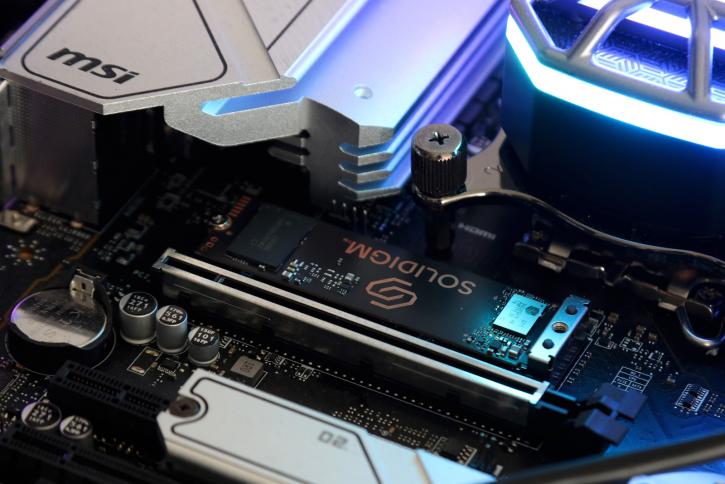Introduction
Solidigm P41 Plus 1TB M.2 NVMe SSD (PCIe Gen 4.0)
Hovering at 4 GB/sec with QLC NAND and a DRAM'less design
So yeah, first a bit of explaining on the brand. SK hynix launched Solidigm earlier this year to manage the company's newly acquired Intel NAND and SSD technology. As a result, the P41 Plus is a direct successor to the Intel 670p, with a more satisfactory performance profile and useful new SSD management tools. The Solidigm P41 Plus, capable of up to 4,125 MB/s sequential read speed, is a breakthrough in cost efficiency, giving exceptional PCIe 4.0 performance at a price that won't break the bank for everyday PC users.
- 512GB : $50
- 1024GB : $90
- 2048GB : $170
The Solidigm P41 Plus is based on 144-layer 3D NAND and is widely available in M.2 2280 sizes of 512 GB, 1 TB, and 2 TB versions. Codenamed Echo Harbor, this is a PCIe 4.0 x4 QLC SSD with 144L QLC NAND from the manufacturer. Because this is a DRAM-less architecture, the translation tables are kept in the Host Memory Buffer (HMB), which is becoming more prevalent for low-cost QLC drives. Silicon Motion's SM2269XT controller powers the new SSD. The SM2269XT, introduced earlier this year, is an improved version of the SM2267XT and serves as the company's standard 4-channel DRAMless controller. The SM2269XT enables NAND transfer speeds of up to 1600 MT/s and can be used with TLC or QLC NAND. It is produced using 12nm technology. The 2269XT has four PCIe 4.0 lanes for host communication and supports the NVMe 1.4 standard.
Solidigm cites moderate transfer rates for the P41 Plus, in par with other QLC-based drives. Sequential read and write speeds are 4,125MB/s (1TB and 2TB models) and 3,325MB/s (2TB model only). The 512GB model reads 3,500MB/s and writes 1,625MB/s. It has a 1.6 million hour MTBF and End-to-End Data Protection, but no hardware encryption.
Silicon Motion SM2267XT controller
Silicon Motion announced a portfolio of PCIe 4.0 NVMe 1.4 controller solutions to address performance, mainstream and value SSD applications. The portfolio consists of SM2264 for performance, SM2267 for mainstream and SM2267XT for value DRAM-less client SSDs.
| SM2267XT | SM2267 | SM2264 | |
| Host Interface | PCIe Gen4 x4 | PCIe Gen4 x4 | PCIe Gen4 x4 |
| PCIe Protocol | NVMe 1.4 | NVMe 1.4 | NVMe 1.4 |
| NAND Flash Channel | 4 | 4 | 8 |
| CE/Channel | 4 | 8 | 8 |
| DRAM | No DRAM | Yes | Yes |
| Max. Performance | |||
| Seq. Read | 3,900 MB/s | 3,900 MB/s | 7,400 MB/s |
| Seq. Write | 3,500 MB/s | 3,500 MB/s | 6,800 MB/s |
| Random Read | 500K IOPS (HMB) 200K IOPS (no HMB) | 500K IOPS | 1,000K IOPS |
| Random Write | 500K IOPS | 500K IOPS | 1,000K IOPS |
For Performance and Automotive PCIe Gen 4 Solutions: SM2264 Gen4 x 4 Lanes, 8 NAND Channel SSD Controllers
Targeted at performance and automotive SSDs, SM2264 features a quad-core ARM R8 CPU with four lanes of 16Gb/s PCIe data flow and supports eight NAND channels with up to 1,600 MT/s per channel. Its advanced architecture, based on 12nm process technology, enables high throughput, lower power consumption, and rigorous data protection while delivering ultra-high speed of sequential read/write performance of up to 7,400/6,800 MBs and random read/write speeds of up to 1,000K IOPs. The quad core ARM R8 CPU offers high multithreaded performance to handle mixed workload operations required by emerging storage applications. SM2264 is designed with Silicon Motion’s state-of-the-art 7th generation NANDXtend™ ECC technology with a performance-optimized 4KB LDPC engine and RAID to maximized error correction capability for the latest and next generation 3D TLC and QLC NAND. SM2264 is also ideal for automotive storage, offering built-in SR-IOV capability that provides direct, high-speed PCIe interface for supporting to up to eight Virtual Machines. SM2264 is currently sampling to leading customers. For Mainstream and Value PCIe Gen 4 SSD Solutions: SM2267 Gen 4x4 Lanes, 4 NAND Channel and SM2267XT Gen4x4 Lanes, 4 NAND Channels, DRAM-less
Controller with Host Memory Buffer
The NVMe SSD Series is produced to become a cost-effective, high-performance SSD. The PCIe-to NAND controller manages a full PCIe Gen 4 (16Gb/s) x 4 bandwidth with the host while managing multiple NAND flash memory devices on (we assume) 4 channels. With Windows 10 Fall Creators Update 2018 and later you are compatible with Host Memory Buffer technology; your system memory substitutes the memory of the drive to cache the map table. Thus not using DRAM SSD cached equals a nice price reduction. The SSD we test today has adopted this DRAMless architecture. HMB leverages Direct Memory Access (DMA) functionality of the PCI-Express interface so that the SSD can operate even without its own DRAM by using the part of the DRAM memory at the system CPU (typically 64MB).
The SSD series comes with a 5-year warranty. For this review, we will focus on the 1TB capacity version withouth a heatsink.


